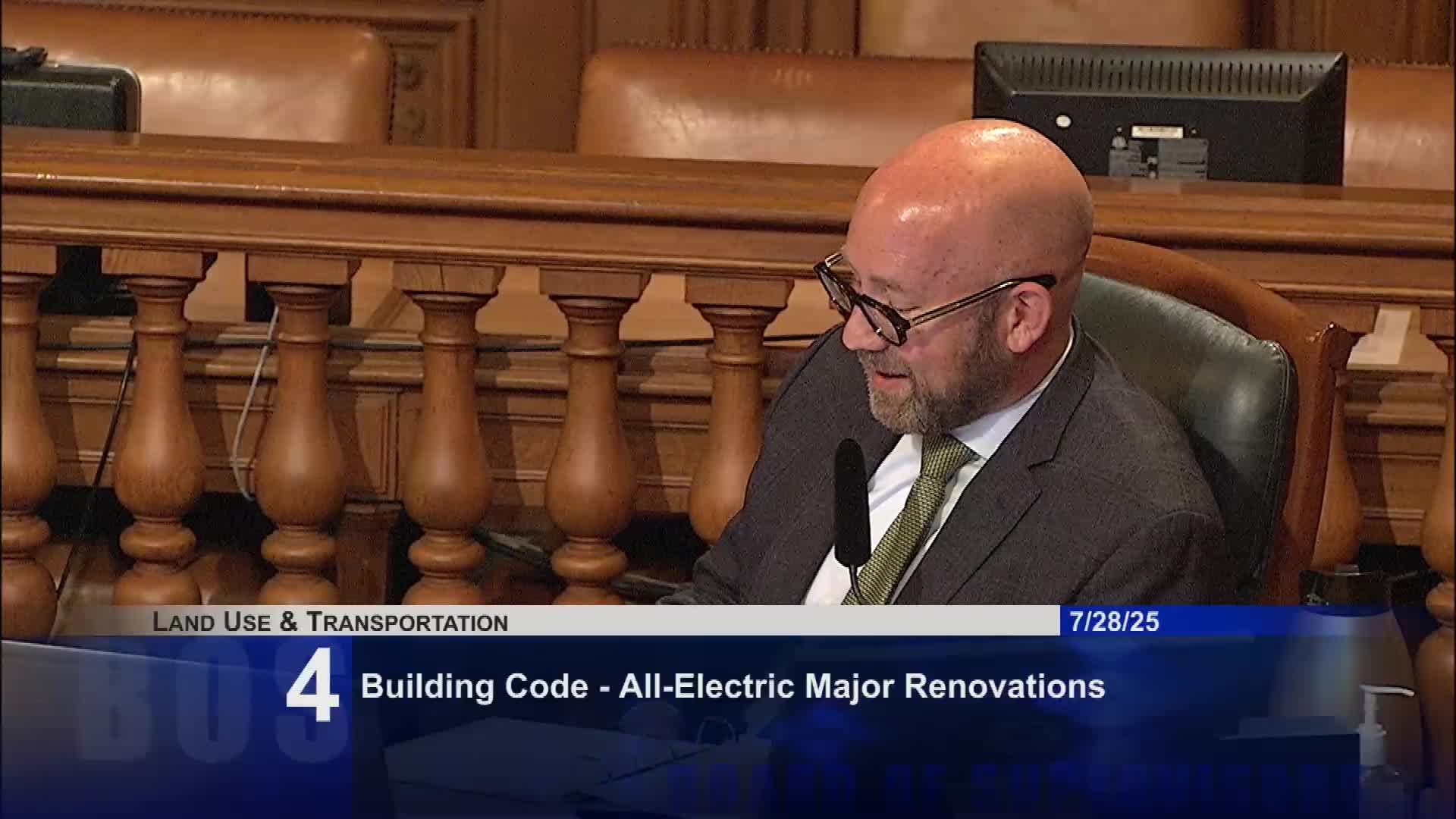San Francisco Board Proposes All Electric Major Renovations Ordinance to Combat Climate Change
July 28, 2025 | San Francisco County, California
This article was created by AI summarizing key points discussed. AI makes mistakes, so for full details and context, please refer to the video of the full meeting. Please report any errors so we can fix them. Report an error »

In a pivotal meeting held on July 28, 2025, San Francisco County officials discussed significant legislation aimed at advancing the city’s climate goals through building electrification. The proposed ordinance seeks to expand the existing all-electric new construction mandate to include major renovations, thereby phasing out natural gas systems in favor of electric alternatives. This initiative is part of a broader strategy to achieve net-zero greenhouse gas emissions by 2040.
The meeting featured remarks from various supervisors, including Board President Mandelmann, who emphasized the long journey leading to this legislation. He highlighted the importance of addressing not only carbon emissions but also the health impacts associated with burning natural gas, particularly in residential settings. Research indicates that indoor air pollution from natural gas contributes significantly to respiratory issues, with one in eight children in the U.S. suffering from asthma linked to this source.
Cindy Commerford from the Department of Environment presented the details of the ordinance, explaining that it would apply to buildings undergoing substantial renovations or expansions. The goal is to ensure that new installations are electric, avoiding costly retrofits in the future. Commerford noted that 44% of San Francisco's greenhouse gas emissions stem from building operations, with 90% of that attributed to natural gas. The ordinance aims to close a loophole in previous regulations and aligns with regional and state efforts to phase out gas appliances.
The discussion also touched on the economic implications of the legislation. While some stakeholders expressed concerns about the potential financial burden on affordable housing developers, others argued that the timing of renovations presents a cost-effective opportunity to transition to electric systems. The ordinance includes exemptions for specific circumstances, such as for affordable housing projects, which will have a phased implementation period to ease the transition.
Public comments reflected a mix of support and concern. Advocates for the ordinance highlighted its potential health benefits and alignment with climate goals, while some affordable housing developers warned that the new requirements could hinder necessary renovations and exacerbate housing shortages. The need for a predictable waiver process for affordable housing projects was a recurring theme among speakers.
In conclusion, the meeting underscored the urgency of addressing climate change through building electrification while balancing the needs of the community, particularly vulnerable populations. As San Francisco moves forward with this legislation, the city aims to set a precedent for sustainable urban development that prioritizes both environmental health and social equity. The ordinance is expected to be finalized and sent to the mayor's desk for approval in the coming weeks, with stakeholders eager to see how it will shape the future of housing and infrastructure in the city.
The meeting featured remarks from various supervisors, including Board President Mandelmann, who emphasized the long journey leading to this legislation. He highlighted the importance of addressing not only carbon emissions but also the health impacts associated with burning natural gas, particularly in residential settings. Research indicates that indoor air pollution from natural gas contributes significantly to respiratory issues, with one in eight children in the U.S. suffering from asthma linked to this source.
Cindy Commerford from the Department of Environment presented the details of the ordinance, explaining that it would apply to buildings undergoing substantial renovations or expansions. The goal is to ensure that new installations are electric, avoiding costly retrofits in the future. Commerford noted that 44% of San Francisco's greenhouse gas emissions stem from building operations, with 90% of that attributed to natural gas. The ordinance aims to close a loophole in previous regulations and aligns with regional and state efforts to phase out gas appliances.
The discussion also touched on the economic implications of the legislation. While some stakeholders expressed concerns about the potential financial burden on affordable housing developers, others argued that the timing of renovations presents a cost-effective opportunity to transition to electric systems. The ordinance includes exemptions for specific circumstances, such as for affordable housing projects, which will have a phased implementation period to ease the transition.
Public comments reflected a mix of support and concern. Advocates for the ordinance highlighted its potential health benefits and alignment with climate goals, while some affordable housing developers warned that the new requirements could hinder necessary renovations and exacerbate housing shortages. The need for a predictable waiver process for affordable housing projects was a recurring theme among speakers.
In conclusion, the meeting underscored the urgency of addressing climate change through building electrification while balancing the needs of the community, particularly vulnerable populations. As San Francisco moves forward with this legislation, the city aims to set a precedent for sustainable urban development that prioritizes both environmental health and social equity. The ordinance is expected to be finalized and sent to the mayor's desk for approval in the coming weeks, with stakeholders eager to see how it will shape the future of housing and infrastructure in the city.
View full meeting
This article is based on a recent meeting—watch the full video and explore the complete transcript for deeper insights into the discussion.
View full meeting
